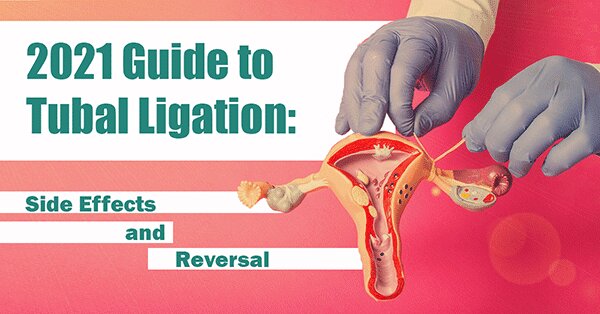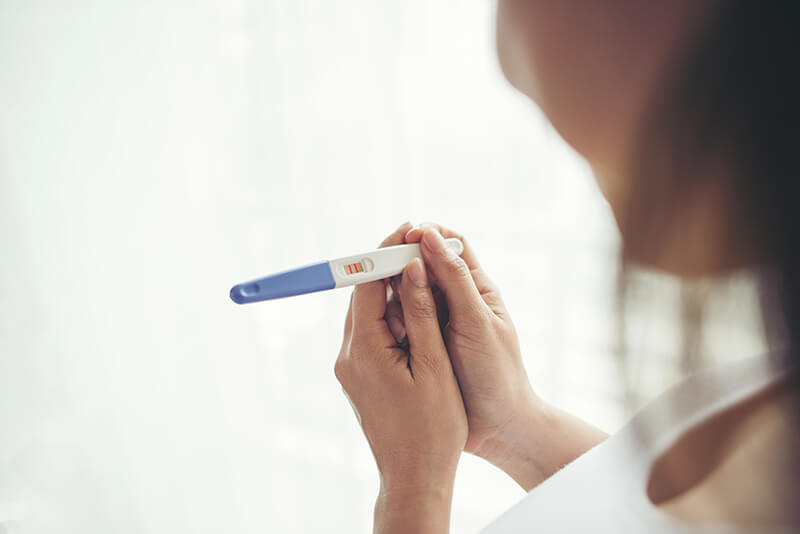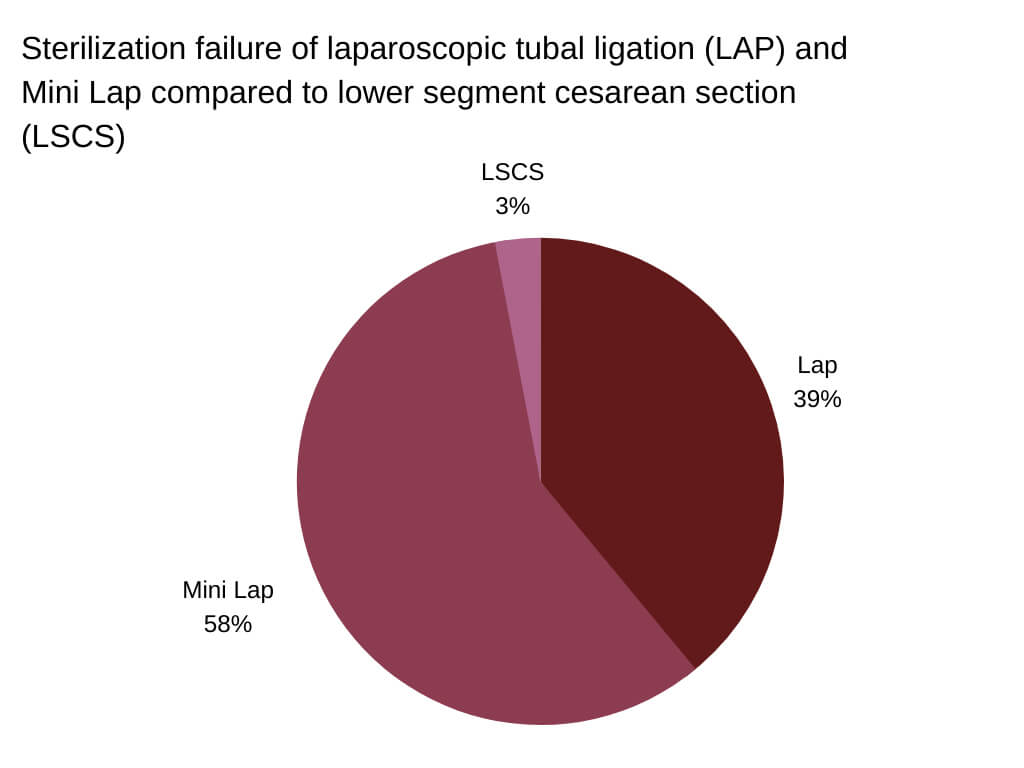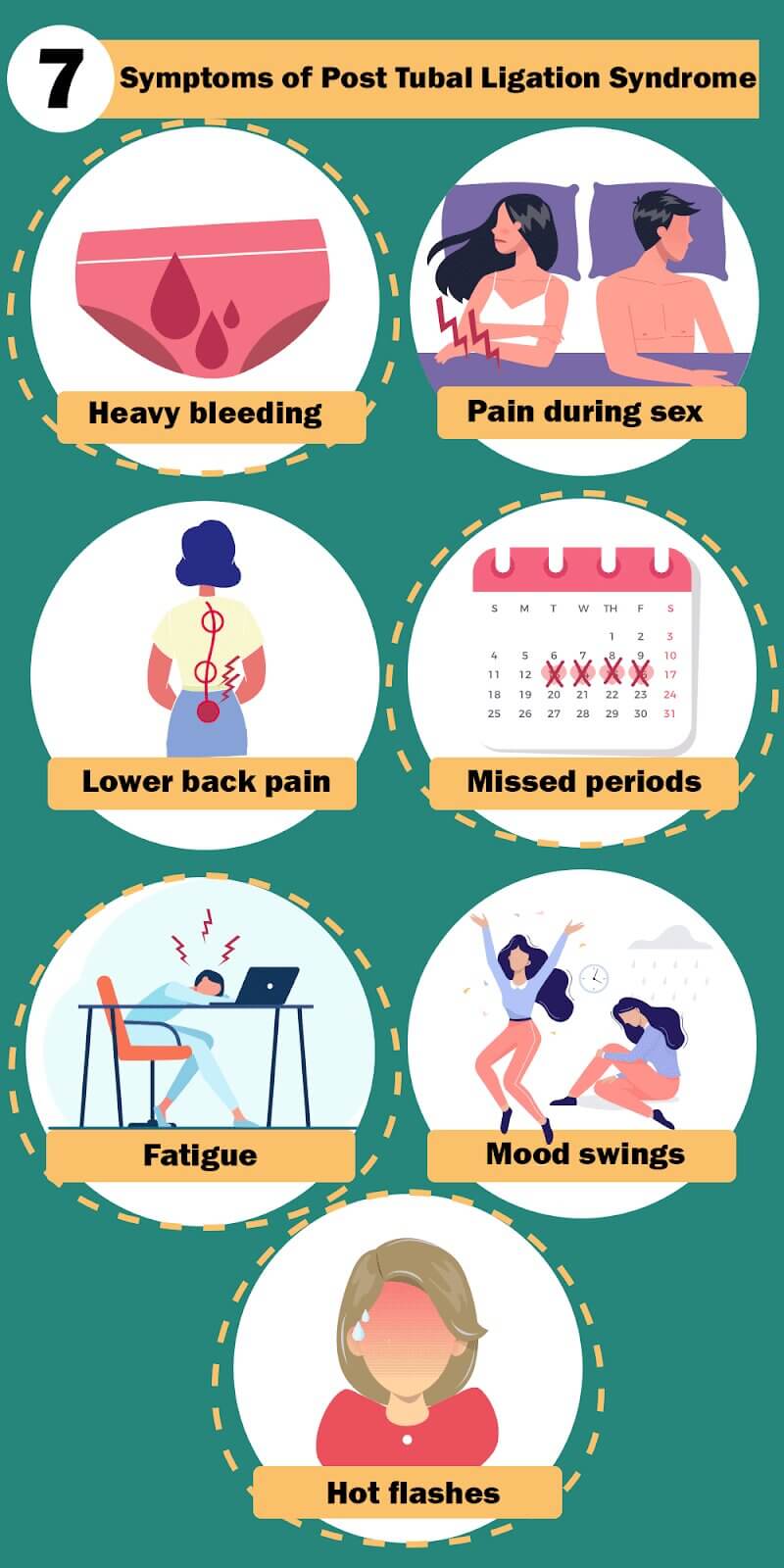
Many women reach a point where they no longer wish to have children. Often this realization is liberating and can bring added benefits to their relationship and quality of life.
For women who seek a form of permanent birth control, getting their tubes tied may be one of their first treatment choices.
As a permanent sterilization technique, tubal ligation offers an excellent success rate at preventing pregnancy, with less than 1 in 1000 women becoming pregnant after undergoing the procedure.
This article discusses the main types of tubal ligation, possible side effects, and the procedure and risks involved in ligation reversal.
Key Takeaways
- Tubal ligation is a form of permanent birth control for women who don’t want more children or women who don’t wish for children at all.
- There are various techniques used for ligation, and most are non-invasive.
- Ligation may result in post tubal ligation syndrome, although medical professionals highly debate the condition.
- Tubal reversal is possible through minor surgery, after which you can get pregnant again.
- Women who had their tubes tied may experience an ectopic pregnancy.
- Alternatives to tubal reversal include IVF, surrogacy, and adoption.
What Are the Types of Tubal Ligation
Tubal ligation surgery does not always follow the same procedure, neither does it involve ‘tying’ your tubes. Instead, two main types of surgery provide a range of options for blocking or disrupting the path of an egg through your fallopian tubes.
Depending on your health, age, and medical history, a doctor may perform one of the following types of ligations [1]:
Laparoscopy
Laparoscopy is one of the most common types of ligation surgery. It involves the administration of general anesthesia and a minimally invasive sterilization procedure.
The fallopian tubes are blocked or disrupted by [1]:
- Mechanical devices: Silicone bands and clips are the two most popular choices. If the tubal lumen is large or dilated, a mechanical device may not be effective. These devices are used to seal off a piece of the fallopian tubes, preventing an egg’s movement to the uterus.
- Tubal excision: A doctor will remove a part, or all, of the fallopian tubes. It is the most effective form of tubal sterilization and offers a high success rate. In addition, a doctor may choose to perform a tubal excision if your fallopian tubes are abnormal.
- Bipolar tubal coagulation: One of the most popular procedures for ligation involves using two rods placed on either side of the fallopian tube, through which an electrical current flows. This electricity cauterizes the tube and causes coagulation, effectively blocking an egg’s route to reach the uterus.
What do you think is the failure rate of laparoscopic tubal ligation?


Laparotomy
A laparotomy is another simple procedure that can be done under general anesthesia. Often laparotomy techniques are used for ligations in postpartum women or those undergoing a c-section.
The most popular options for ligation during a laparotomy include the [1]:
- Pomeroy technique: It is one of the most popular techniques and is the origin of the phrase ‘tying your tubes.’ The Pomeroy method involves folding a part of the fallopian tube and tying it up with a suture, then cutting off a piece of the tube at the top of the fold.
- Parkland technique: Involves placing two sutures on different parts of the fallopian tubes and excising the tube in between them.
Although other methods like the Uchida or Irving technique may be used, they are by no means the most popular.
The average procedure time is around 30 minutes.
Tubal Ligation Side Effects: Potential Complications After Tubal Ligation Surgery
Most of the side effects you may experience after ligation surgery are related to the surgery and anesthetic themselves and not the procedure.
General Side Effects
Similar to the general vasectomy side effects and reversal symptoms, the effects of tubal sterilization are primarily due to the surgical procedure itself.
These possible side effects include:
- Minor bleeding around the surgical incisions, especially if a laparotomy was performed.
- Reactions to anesthesia, including delirium, drowsiness, confusion, and hypothermia [2]
Although the ligation procedure is simple, some patients may also experience mild abdominal pain due to the effects of the surgery.
Another common fear when opting for a tubal ligation procedure is that it may increase your risk of getting breast cancer. However, the surgery actually does the opposite [3].
Tubal Ligation Clips Side Effects
In the case that your fallopian tubes were clipped, there are various possible adverse effects, including [4]:
- Tubal necrosis
- Sterilization failure
- Abdominal pain
Postpartum Tubal Ligation Side Effects
If your doctor performed a ligation during a cesarean section, you might experience the symptoms accompanying the c-section with greater intensity than those caused by the ligation.
- Pelvic pain
- Increased chance of developing asthma or allergies
Post Tubal Ligation Syndrome (PTLS)
Post tubal ligation syndrome involves a range of adverse symptoms affecting a woman after undergoing tubal sterilization.
The FDA does not recognize PTLS as a side effect of tubal ligation, and it is at the center of many debates within the medical community [7].
Symptoms of Post Tubal Ligation Syndrome
The symptoms of PTLS are believed to be caused by issues with blood circulation around the ovaries and fallopian tubes.
They include [8]:

- Heavy bleeding
- Pain during sex
- Lower back pain
- Missed periods
- Fatigue
- Mood swings
- Hot flashes
Is Getting Your Tubes Tied Reversible?
If you find yourself having regrets after tubal sterilization, tubal reversal surgery could reverse the procedure and get you pregnant again.
During a tubal reversal, a doctor will either untie or reconnect your fallopian tubes, depending on the procedure used for the ligation.
If you’re thinking about getting tubal reversal surgery, talk to your health care provider about your options and whether a reversal is right for you.
Patient Age and Overall Health
If opting for reversal surgery, younger women usually have a far better chance of becoming pregnant than older women [9].
Your overall health may also impact your doctor’s recommendation, especially considering a body mass index of more than 25 decreases the chance of getting conceiving after reversal [10].
Type of Surgery Performed
A doctor’s recommendation for tubal reversal surgery will also depend on the sterilization procedure followed. For a successful reversal, your remaining fallopian tubes must be long enough to be reconnected.
The sterilization method won’t necessarily affect your success rate. It may simply impact the type or viability of the reversal surgery used [11].
Reproductive System Health
Another factor that may affect your doctor’s recommendation for tubal reversal surgery is your overall reproductive system health.
This will include checking that your uterus, ovaries, and other reproductive organs are healthy and functioning. Otherwise, reversal surgery may be unnecessary.
Your partner may also undergo a semen analysis to ensure no other conditions will keep you from getting pregnant after a reversal.
Tubal Ligation Reversal Surgery: What to Expect
Tubal ligation reversal, also known as tubal reanastomosis, is an outpatient procedure, so you don’t typically need to stay in hospital overnight.
If you decide you want to become pregnant after a ligation, a doctor will consider your medical history and recommend you for a reversal.
Procedure
Tubal ligation reversal surgery involves a non-invasive operation under anesthesia.
The most common method is through laparoscopic microsurgery, which first involves inserting a laparoscope that lets the surgeon see and decide whether your fallopian tubes are suited for a reversal.
The surgeon then makes a small incision just above your pubic hairline through which the laparoscope, accompanied by microscopic surgical instruments, is inserted.
These instruments are used to remove any clips, bands, or sutures constricting the fallopian tubes, and the tubal segments of the remaining fallopian tubes are stitched back together.
The entire surgery takes around three hours [12].
Complications and Risks
Tubal reversal surgery comes with its own set of risks, including:
- Higher risk of ectopic pregnancy occurs when the fertilized egg grows and implants in the Fallopian tube instead of the uterus [13]. If the pregnancy is not terminated, it could become a life-threatening condition.
- Infection or bleeding due to the surgery. This could be especially serious if the infection spreads to nearby organs.
- Formation of scar tissue on the fallopian tubes.
- Anesthesia side effects.
Recovery
Tubal reversal is an outpatient surgery that does not require an overnight hospital stay.
Your doctor can prescribe painkillers to deal with the after-effects of the surgery and may also arrange for a follow-up appointment to check on your recovery and healing.
Most patients only experience mild discomfort for several days after the surgery and can typically return to their jobs after around five days, depending on their recovery rate, and provided they do no heavy lifting.
In most cases, patients should be able to resume all their normal activities two weeks post-operation.
Since ligation is a form of non-hormonal birth control, you may be able to get pregnant immediately after the reversal procedure, although attempting to do so is not recommended.
Tubal Ligation Reversal Success Rate
Tubal reversal surgery success rates vary significantly from person to person. After undergoing tubal anastomosis, the average overall pregnancy rates range between 55% and 74% [14, 15].
Some women who achieve pregnancy after tubal anastomosis experience an ectopic pregnancy, which is a serious condition, and the resulting pregnancy is rarely carried to term.
As a result of the wide range in the tubal reversal success rate, some women choose to get pregnant or have children through alternative methods.
Tubal Ligation Reversal Cost
The average tubal reversal surgery cost is $6,800. This includes all pre- and post-operative consultations and care. Many insurance plans don’t cover tubal reversal after a fully informed and consensual tubal ligation was performed.
What’s Cheaper: IVF or Tubal Reversal?
On average, one IVF cycle costs $12,000, while additional medication may add an extra $3,000-$5,000 to the total. Many women don’t get pregnant on the first cycle and may need to undergo several more.
Compared to IVF, tubal reversal surgery is far more affordable and may be the better option for some, despite the variation in success rates.
Tubal Ligation Reversal Alternatives
If your doctor recommends against tubal reversal or doesn’t feel it is right for you, there are other alternatives for having children or getting pregnant.
Another option for permanent birth control is a male vasectomy, reviewed in our comprehensive article on vasectomy side effects and reversal.
IVF
In vitro fertilization involves fertilizing an egg by sperm outside the human body, usually in a test tube.
The fertilized egg is then transferred to your uterus through a thin tube. If the embryo implants, pregnancy occurs.
The average pregnancy rate through IVF is 30% for women under 36 and 15% for those 37 or older [16].

Surrogacy
Another alternative to ligation reversal is surrogacy, during which another woman, or surrogate, carries and delivers the baby for you and your partner.
There are two types of surrogates:
- Traditional: A traditional surrogate is artificially inseminated with your male partner’s sperm. The baby will share her DNA but will be yours to raise.
- Gestational: Gestational surrogacy is the most popular option for women seeking an alternative to ligation reversal. It involves the in vitro fertilization of your egg by your partner’s sperm, after which the embryo is transferred to the surrogate’s uterus [17].
Pregnancy statistics for gestational surrogates average around 60% [17]
Adoption
Adoption is another excellent alternative for ligation reversal. It requires serious consideration, and not all couples may feel comfortable adopting a child instead of going through a pregnancy. However, for those who choose to adopt and do so with a positive outlook, the experience can be incredibly rewarding [18].
FAQ
Here are the answers to the most frequently asked questions about ligation and reversal.
Are Tubal Ligation Side Effects Common?
No, the side effects of ligation surgery are not common, and if they do occur, most are mild [19].
Can You Reverse Tubal Ligation Naturally?
Unfortunately, natural tubal reversal is not possible. Instead, a doctor must do it through minor surgery.
What Are the Symptoms of Tubes Coming Untied?
It is nearly impossible for ligation to fail and for you to become pregnant after the procedure. The slight possibility of this happening is likely due to technical mistakes occurring during surgery.
If a surgical mistake was made and your tubes grow back together, you may become pregnant and experience symptoms such as [20]:
- Missed periods
- Frequent urination
- Fatigue
- Insomnia
- Lower back pain
If you’ve had ligation surgery and think you may be pregnant, visit your doctor immediately.
What Are Tubal Ligation Regret Statistics?
The category of women most likely to regret getting their tubes tied includes those without children, those under the age of 30, and getting the procedure done within 45 days after childbirth.
For women under the age of 30, the percentage who expressed regret averaged around 20%, while those over 30 had a 6% regret rate [21].
Conclusion
Regardless of your reasons for undergoing ligation, the side effects should be minor, and there are various options for tubal reversals.
Although ligation reversal does not have a 100% success rate, it is still more effective at producing a pregnancy than any alternative.
As long as you consider the risks and make an informed decision, both ligation and a tubal ligation reversal could help you take control of your reproductive cycle.
References:
- Sung, Sharon. “Tubal Ligation.” StatPearls [Internet]., U.S. National Library of Medicine, 1 Mar. 2021, www.ncbi.nlm.nih.gov/books/NBK549873/.
- Goldfuss, Sophia, et al. “Anaesthesia-Related Complications and Side-Effects in TAVI: a Retrospective Study in Germany.” BMJ Open, BMJ Publishing Group, 1 May 2019, www.ncbi.nlm.nih.gov/pmc/articles/PMC6501997/.
- Eliassen, A. Heather, et al. “Tubal Sterilization in Relation to Breast Cancer Risk.” Wiley Online Library, John Wiley & Sons, Ltd, 11 Nov. 2005, onlinelibrary.wiley.com/doi/full/10.1002/ijc.21582.
- Konaté A;Rauzy V;Chalon S;Ceballos P;Rivière S;Ciurana AJ;Le Quellec A; “[Intraperitoneal Migration of Filshie Tubal Sterilization Clips: an Uncommon Cause of Chronic Abdominal Pain].” Gastroenterologie Clinique Et Biologique, U.S. National Library of Medicine, pubmed.ncbi.nlm.nih.gov/12193864/.
- Keag, Oonagh E, et al. “Long-Term Risks and Benefits Associated with Cesarean Delivery for Mother, Baby, and Subsequent Pregnancies: Systematic Review and Meta-Analysis.” PLoS Medicine, Public Library of Science, 23 Jan. 2018, www.ncbi.nlm.nih.gov/pmc/articles/PMC5779640/.
- Sandall J;Tribe RM;Avery L;Mola G;Visser GH;Homer CS;Gibbons D;Kelly NM;Kennedy HP;Kidanto H;Taylor P;Temmerman M; “Short-Term and Long-Term Effects of Caesarean Section on the Health of Women and Children.” Lancet (London, England), U.S. National Library of Medicine, pubmed.ncbi.nlm.nih.gov/30322585/#:~:text=Short%2Dterm%20risks%20of%20CS,reduced%20intestinal%20gut%20microbiome%20diversity.
- DW;, Gentile GP;Kaufman SC;Helbig. “Is There Any Evidence for a Post-Tubal Sterilization Syndrome?” Fertility and Sterility, U.S. National Library of Medicine, pubmed.ncbi.nlm.nih.gov/9496325/.
- H;, Satoh K;Osada. “[Post-Tubal Ligation Syndrome].” Ryoikibetsu Shokogun Shirizu, U.S. National Library of Medicine, pubmed.ncbi.nlm.nih.gov/7757737/.
- Godin, Pierre Arnaud, et al. “Laparoscopic Reversal of Tubal Sterilization; A Retrospective Study Over 135 Cases.” Frontiers in Surgery, Frontiers Media S.A., 9 Jan. 2019, www.ncbi.nlm.nih.gov/pmc/articles/PMC6333701/.
- MM;, Hanafi. “Factors Affecting the Pregnancy Rate after Microsurgical Reversal of Tubal Ligation.” Fertility and Sterility, U.S. National Library of Medicine, pubmed.ncbi.nlm.nih.gov/12909510/.
- Kim SH;Shin CJ;Kim JG;Moon SY;Lee JY;Chang YS; “Microsurgical Reversal of Tubal Sterilization: a Report on 1,118 Cases.” Fertility and Sterility, U.S. National Library of Medicine, pubmed.ncbi.nlm.nih.gov/9389817/.
- K;, Dubuisson JB;Swolin. “Laparoscopic Tubal Anastomosis (the One Stitch Technique): Preliminary Results.” Human Reproduction (Oxford, England), U.S. National Library of Medicine, pubmed.ncbi.nlm.nih.gov/8567838/.
- D;, Liu J;Fa Y;Lou. “[Relationship between Microsurgical Tubal Reversal and Ectopic Pregnancy].” Zhonghua Yi Xue Za Zhi, U.S. National Library of Medicine, pubmed.ncbi.nlm.nih.gov/9772502/.
- Karayalcin, Rana, et al. “Pregnancy Outcome of Laparoscopic Tubal Reanastomosis: Retrospective Results from a Single Clinical Centre.” The Journal of International Medical Research, SAGE Publications, June 2017, www.ncbi.nlm.nih.gov/pmc/articles/PMC5536424/.
- Schepens JJ;Mol BW;Wiegerinck MA;Houterman S;Koks CA; “Pregnancy Outcomes and Prognostic Factors from Tubal Sterilization Reversal by Sutureless Laparoscopical Re-Anastomosis: a Retrospective Cohort Study.” Human Reproduction (Oxford, England), U.S. National Library of Medicine, pubmed.ncbi.nlm.nih.gov/21115505/.
- Dicker D;Goldman JA;Ashkenazi J;Feldberg D;Shelef M;Levy T; “Age and Pregnancy Rates in in Vitro Fertilization.” Journal of in Vitro Fertilization and Embryo Transfer : IVF, U.S. National Library of Medicine, pubmed.ncbi.nlm.nih.gov/1919259/.
- PR;, Brinsden. “Gestational Surrogacy.” Human Reproduction Update, U.S. National Library of Medicine, pubmed.ncbi.nlm.nih.gov/14640380/.
- Y;, Sánchez-Sandoval. “[Adoptive Parents’ Satisfaction with the Adoption Experience and with Its Impact on Family Life].” Psicothema, U.S. National Library of Medicine, pubmed.ncbi.nlm.nih.gov/22047850/.
- Marino, Sarah. “Tubal Sterilization.” StatPearls [Internet]., U.S. National Library of Medicine, 7 Sept. 2020, www.ncbi.nlm.nih.gov/books/NBK470377/.
- Foxcroft, Katie F, et al. “Development and Validation of a Pregnancy Symptoms Inventory.” BMC Pregnancy and Childbirth, BioMed Central, 16 Jan. 2013, www.ncbi.nlm.nih.gov/pmc/articles/PMC3599678/.
- HB;, Hillis SD;Marchbanks PA;Tylor LR;Peterson. “Poststerilization Regret: Findings from the United States Collaborative Review of Sterilization.” Obstetrics and Gynecology, U.S. National Library of Medicine, pubmed.ncbi.nlm.nih.gov/10362150/.



Leave a Reply